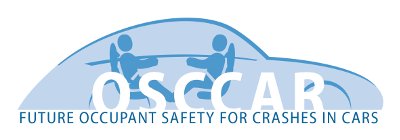Work Description
- # Determination of future accident scenarios
- # Development of advanced occupant protection principles
- # Human Body Models for assessment of new safety systems in future vehicles
- # Development of robust and efficient crash simulation tools for integrated assessment & overall impact demonstration
- # Standardization of virtual testing
- # Project Communication, dissemination and exploitation
Determination of future accident scenarios
Objectives:
- To apply accident research and to combine it with future trend analysis and insights from other real world data in order to derive an outlook to future remaining or changing accident scenarios
- Development and application of the open source accident simulation tool openPASS to predict the influence of automation and active safety based on accident data and traffic models for mixed human/automated traffic
- To describe future scenarios considering the possible positive effects of supervised and non-supervised driving and also account for solutions from the field of Cooperative Intelligent Transport Systems (C-ITS).
- Analysis of relevant future accident scenarios and delivery of a “future collision type matrix” for the advanced development of new safety systems and virtual tools.
Development of advanced occupant protection principles
Objectives:
- Perform a user study regarding future occupant expectations from HAV sitting positons and commodities
- Definition of a future test cases
- Development of advanced passenger protection principles
- Demonstration and validation of selected protection principles
Human Body Models for assessment of new safety systems in future vehicles
Objectives:
- To provide new biomechanical data and a biomechanical database necessary for the development of future active and passive HBMs and standardized validation of these models.
- To provide mathematical models of the loading environments used in the original biomechanical tests and that are included in the above mentioned database.
- To improve active and passive HBMs to be ready for use in industrial applications and in assessment programs. These HBMs are to be capable of simulation active and reactive pre-crash occupant behaviour and predict the pre- and in-crash injury risk in existing and future accident scenarios and taking into account existing and future sitting positions of the occupants. The injuries to be predicted are not only the fatal and sever injuries but also the minor injuries; those known to lead to long term disabilities and those that may arise during repositioning the occupant prior to an emerging crash.
- To provide HBMs that are representative of a large proportion of the vehicle occupants at risk.
Development of robust and efficient crash simulation tools for integrated assessment & overall impact demonstration
Objectives:
- Generate a general tool-independent quality check method/ tool for virtual testing with HBMs.
- Develop an integrated assessment tool chain for crash simulation including HBMs for MBS and for FEM simulation using the same general input and assessment method.
- Demonstrate the effectiveness of the new advanced protections system when developed with adequate HBMs and their possible impact on occupant road safety incl. demonstration of exemplary homologation scenario.
Standardization of virtual testing
Objectives:
The overall aim is to make recommendations for substantial use of virtual testing for complex testing scenarios to support and (partially) replace hardware crash tests in the future. Therefore, the implementation of “future HBM” in Virtual V&V (“Pilot cases”) as well as the consideration of a “future collision matrix” and process to address pre-crash parameters variety within regulations & consumer tests will be prepared. An international Harmonization and Standardization of complex testing methods for advanced protection systems will be approached.
Project Communication, dissemination and exploitation
Objectives:
The overall aim of WP6 is to increase the visibility and support the impact generation of the OSCCAR project and its project results. To ensure achievement of this aim, the necessary dissemination and communication activities will be planned and undertaken. In addition, a continuous evaluation of impact and planning of exploitation activities is to be conducted.
- To maximise the dissemination of results and to express them in terms that are readily understandable to stakeholders in industry, suppliers and governments in order to accelerate the implementation of the research findings
- To promote the dissemination of the project findings through presentations at project workshops, technical conferences, scientific publications and the project website
- To facilitate technology transfer and accelerate dissemination of the on-going project activities
- To achieve an optimum knowledge management including appropriate handling of IPR; implementation and exploitation of the obtained results
